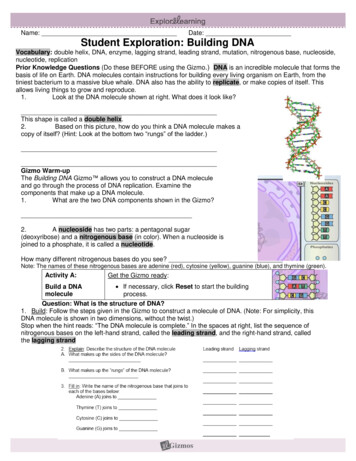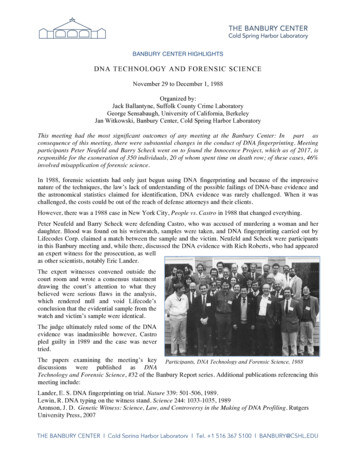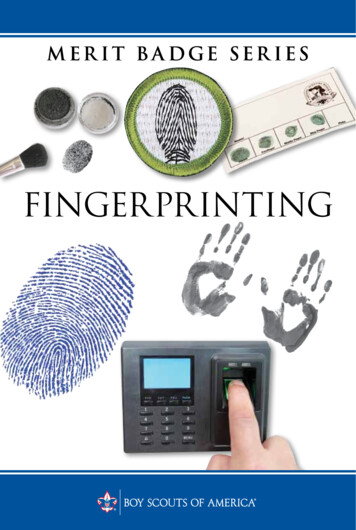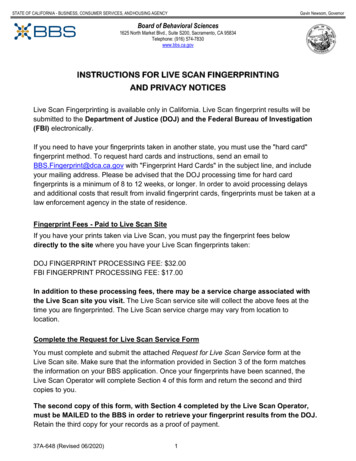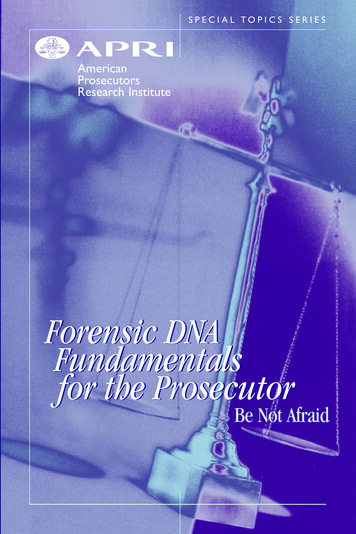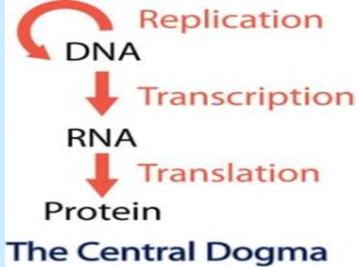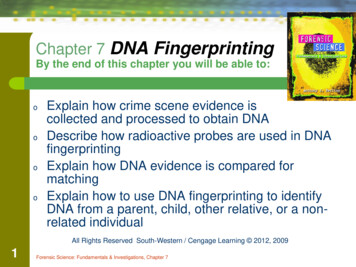
Transcription
Chapter 7 DNA FingerprintingBy the end of this chapter you will be able to:ooooExplain how crime scene evidence iscollected and processed to obtain DNADescribe how radioactive probes are used in DNAfingerprintingExplain how DNA evidence is compared formatchingExplain how to use DNA fingerprinting to identifyDNA from a parent, child, other relative, or a nonrelated individualAll Rights Reserved South-Western / Cengage Learning 2012, 20091Forensic Science: Fundamentals & Investigations, Chapter 7
Introductionoooo2Except for identical twins, no 2 people havethe same DNA.Since 1908s DNA has been used toinvestigate crimes, establish paternity, IDvictims of war and large scale disasters.DNA is individual evidenceAnalysis of chromosomes of a sample ofcells is karyotypingForensic Science: Fundamentals & Investigations, Chapter 7
History of BiologicalEvidence in Forensicsooooooo3James Watson and Francis Crick--1953 discovered theconfiguration of the DNA moleculeRay White--1980 describes first polymorphic RFLPmarkerAlec Jeffreys--1985 isolated DNA markers and calledthem DNA fingerprintsKary Mullis--1985 developed PCR testing1988--FBI starts DNA casework1991--first STR paper1998--FBI launches CODIS database.Forensic Science: Fundamentals & Investigations, Chapter 7
History of BiologicalEvidence in ForensicsDNA profilingo DNA can be extracted from small amounts ofbiological evidenceBiological evidence is examined for thepresence of inherited traitsExamples of Biological evidenceooo 4Also known as DNA fingerprintingUsed with a high degree of accuracySkin, blood, saliva, urine, semen, and hairForensic Science: Fundamentals & Investigations, Chapter 7
The Functionand Structure of DNAooo5DNA contains the genetic material of a cell; holdsall of the instructions needed for a cell to makeproteins and to replicate.Chromosomes are located in the cell nucleusChromosomes contain long DNA strands wrappedaround proteinsForensic Science: Fundamentals & Investigations, Chapter 7
What is a chromosome?ooo6In the nucleus of each cell, the DNAmolecule is packaged into thread-likestructures called chromosomes.Each chromosome is made up of DNA tightlycoiled many times around proteins calledhistones that support its structure.Chromosomes are not visible in the cell’snucleus—not even under a microscope—when the cell is not dividing.Forensic Science: Fundamentals & Investigations, Chapter 7
What is a chromosome?oo7However, the DNA that makes upchromosomes becomes more tightly packedduring cell division and is then visible under amicroscope.Most of what researchers know aboutchromosomes was learned by observingchromosomes during cell division.Forensic Science: Fundamentals & Investigations, Chapter 7
What is a chromosome?ooo8Each chromosome has a constriction pointcalled the centromere, which divides thechromosome into two sections, or “arms.”The short arm of the chromosome is labeledthe “p arm.”The long arm of the chromosome is labeledthe “q arm.”Forensic Science: Fundamentals & Investigations, Chapter 7
What is a chromosome?o9The location of the centromere on eachchromosome gives the chromosome itscharacteristic shape, and can be used tohelp describe the location of specific genes.Forensic Science: Fundamentals & Investigations, Chapter 7
10Forensic Science: Fundamentals & Investigations, Chapter 7
The Functionand Structure of DNAo11Double helix--two coiled DNA strandsForensic Science: Fundamentals & Investigations, Chapter 7
The Functionand Structure of DNAo12Composed of nucleotides--unit containing a sugarmolecule (deoxyribose), phosphate group and anitrogen-containing baseForensic Science: Fundamentals & Investigations, Chapter 7
The Functionand Structure of DNAooNitrogenous Bases—pairs of molecules thatform the rungs of the DNA “ladder”Four types of Bases oBase-Pairing Rules 13A (adenine)C (cytosine)G (guanine)T (thymine) adenine (A) binds only with thymine(T)Cytosine (C) binds only with guanine (G)
The Functionand Structure of DNAoBase-Pairing Rules 14adenine (A) binds onlywith thymine(T)Cytosine (C) binds onlywith guanine (G)Forensic Science: Fundamentals & Investigations, Chapter 7
The Functionand Structure of DNAoo15Human DNA consists of about 3 billionbases, and more than 99 percent of thosebases are the same in all people.The order, or sequence, of these basesdetermines the information available forbuilding and maintaining an organism, similarto the way in which letters of the alphabetappear in a certain order to form words andsentences.Forensic Science: Fundamentals & Investigations, Chapter 7
What is a gene?ooo16A gene is the basic physical and functionalunit of heredity.Genes, which are made up of DNA, act asinstructions to make molecules calledproteins.In humans, genes vary in size from a fewhundred DNA bases to more than 2 millionbases.Forensic Science: Fundamentals & Investigations, Chapter 7
What is a gene?oo17Every person has two copies of each gene,one inherited from each parent.Most genes are the same in all people, but asmall number of genes (less than 1 percentof the total) are slightly different betweenpeople.Forensic Science: Fundamentals & Investigations, Chapter 7
What is a gene?oo18Alleles are forms of the same gene with smalldifferences in their sequence of DNA bases.These small differences contribute to eachperson’s unique physical features.Forensic Science: Fundamentals & Investigations, Chapter 7
GenesEach gene has a locus,a specific positionon a pair ofhomologous chromosomes
AllelesAn allele is analternative form of agene-Each parentdonates one allelefor every geneooPea plants have 2 alleles forshape - they receive one fromeach parentFor shape, there is a wrinkledallele and a round allele
21Forensic Science: Fundamentals & Investigations, Chapter 7
Genes influence the development oftraitsooAll of an organism’s genetic materialis called the genomeA genotype A phenotype is thephysical expression of a trait
Genotype: refers to the actualgenes1. The gene combination of an organismo It consists of 2 allelesoFor example: Pure dominant, 2 dominant genes Pure recessive, 2 recessive genes Hybrid, 1 dominant and 1 recessive gene
Phenotype: physical expressionof a traitThe way an organism lookso No matter what genes arepresent, phenotype of a tallpea plant is tall and a shortpea plant is short
25Forensic Science: Fundamentals & Investigations, Chapter 7
Collection andPreservation of DNA1. Use disposable gloves and collection2.3.4.5.26instrumentsAvoid physical contact, talking, sneezing, andcoughing in the evidence areaAir-dry evidence and put it into new paper bagsor envelopesDry or freeze the evidenceKeep evidence cool and dry duringtransportation and storageForensic Science: Fundamentals & Investigations, Chapter 7
DNA Identificationoo27Polymorphisms: Non-coded (junk) DNA thatcontain unique patterns of repeated basesequences that that are unique to individualsRFLP - Restriction Fragment Length PolymorphismForensic Science: Fundamentals & Investigations, Chapter 7
Non-Coding DNA (junk)ooo283 percent of the human DNA sequencescode for proteins97 percent is non-coding and is repetitive;repeating the same sequence over and over50 percent of the human genome hasinterspersed repetitive sequencesForensic Science: Fundamentals & Investigations, Chapter 7
29Forensic Science: Fundamentals & Investigations, Chapter 7
DNA ProfileRepeating DNA sequencesoVariable Numbers of Tandem Repeats (VNTR) oShort Tandem Repeats (STR) o2 to 5 bases in lengthShorter lengths make STRs easier to use than VNTRsVNTR and STR data are analyzed for 30The number of repeats varies from person to person9 to 80 bases in lengthtissue matchinginheritance matchingForensic Science: Fundamentals & Investigations, Chapter 7
RFLP--Restriction FragmentLength PolymorphismsooooFragments are cut from the sequence ofbases by a restriction enzyme.The enzyme find its combination, bonds atone end and dissolves through the DNA atthe other.Fragments are loaded into a gel and run byelectrophoresis.DNA is extracted from the gel by blotting itinto a nylon membrane.31
RFLP--Restriction FragmentLength PolymorphismsooRadioactive phosphorus-32 probes areadded to the membrane which bond to theprecise DNA fragments making themradioactive.Then the membrane is placed over standardX-ray film where the radiation emitted fromthe P-32 gradually exposes the film andshows the DNA bands.This process takes about 10 weeks tocomplete.32
33Forensic Science: Fundamentals & Investigations, Chapter 7
Short Tandem Repeats (STR)ooooSTR is the latest method of DNA typing.STR’s are locations (loci) on thechromosomecontain short sequences of 3 to 7 basesthat repeat themselves with the DNAmolecule.advantages include a higherdiscrimination than RFLP, less time,smaller sample size, and less susceptible34to degradation.
35Forensic Science: Fundamentals & Investigations, Chapter 7
STRSTR typing is visualized by peaks shown on agraph. Each represents the size of the DNAfragment.The possible alleles are numbered for eachloci.36
Profiler Plus Allelic D18S51D7S820
Population GeneticsStudy of variation in genes among a group ofindividuals; proportion of people with aspecific trait is determined by the proportionof alleles for those traits.Ex.) among Asian populations, blue eyes arerare, so few people in that population have theallele that codes for blue eyes.o38Forensic Science: Fundamentals & Investigations, Chapter 7
Population GeneticsEx.) Blood groupsAlmost 100% of South Americans have type O39Forensic Science: Fundamentals & Investigations, Chapter 7
Preparing DNA Samplesfor Fingerprinting1. DNA is mixed with special enzymes2. Enzymes cut apart the DNA in specificplaces forming different sized fragments3. DNA is separated within an agarose gel4. An electric current is passed through the gelseparating the fragments by size40Forensic Science: Fundamentals & Investigations, Chapter 7
Preparing DNA Samplesfor FingerprintingExtraction1. Cells are isolated from biological evidence suchas blood, saliva, urine, semen, and hair2. The cells are disrupted to release the DNAfrom proteins and other cell components3. The DNA can be extracted from the cellnucleus41Forensic Science: Fundamentals & Investigations, Chapter 7
Preparing DNA Samplesfor FingerprintingAmplificationoo42VNTR analyses—polymerase chain reaction(PCR) can be used to amplify the DNA thatcontains the VNTRsSTR profiles—restriction enzymes areunnecessary; PCR allows the amplification of thestrands with STR sequencesForensic Science: Fundamentals & Investigations, Chapter 7
PCR--Polymerase Chain ReactionPCR is a technique for making many copies of adefined segment of a DNA molecule. It looksat six different inherited traits, each controlledby a specific gene. Every gene has at leasttwo alternative forms called alleles. Anindividual receives one allele from mother andone from father. If the alleles are the same,the individual is said to be homozygous for thetrait; if the two alleles are different, theindividual is heterozygous.43
PCR--Polymerase Chain ReactionoooHeat the DNA strands which causes thestrands to separate (unzip).Cool the mixture and add primers, a shortsequence of base pairs that will add to itscomplementary sequence on the DNAstrand.Finally, add a DNA polymerase and amixture of free nucleotides to the separatedstrands. Heat again to around 75 degrees Cfor the completion.44
PCR--Polymerase Chain ReactionThe outcome is a doubling of the number DNAstrands. Heating, cooling, and strandrebuilding is repeated typically 25 to 30times, yielding more than one million copiesof the original DNA molecule. Each cycletakes less than two minutes from start tofinish.45
Preparing DNA Samplesfor FingerprintingElectrophoresis46oDNA samples are placed in gels through whichelectronic currents are passedoDNA fragments line up in bands along the length ofeach gelForensic Science: Fundamentals & Investigations, Chapter 7
Electrophoresisoo47An electrophoresisapparatus running fivesample of DNAArrows show the movementof the negatively chargedDNA fragments through thegel matrixForensic Science: Fundamentals & Investigations, Chapter 7
ElectrophoresisAn electrical current moves through asubstance causing molecules to sort by size.Smaller, lighter molecules will move thefurthest on the gel.48
ElectrophoresisPipette the DNA.
Electrophoresis (cont.)Load DNA into the gelwells.50
Electrophoresis (cont.)51oRun the gel.oObserve andcompare bands ofDNA.
Gel Analysis52Forensic Science: Fundamentals & Investigations, Chapter 7
Analysis of DNAFingerprints and ApplicationsBands and widths are significant inmatching samples of DNA53Forensic Science: Fundamentals & Investigations, Chapter 7
Three Possible Outcomes Match--The DNA profile appears the same. Labwill determine the frequency. Exclusion – The genotype comparison showsprofile differences that can only be explained bythe two samples originating from differentsources. Inconclusive – The data does not support aconclusion as to whether the profiles match.54
DNA Profile MatchingoTissue Matching oInheritance Matching 55Two samples that have the same band patternare from the same personEach band in a child’s DNA fingerprint must bepresent in at least one parentForensic Science: Fundamentals & Investigations, Chapter 7
ProbesoDNA probes o56identify the unique sequences in a person’s DNAare made up of different synthetic sequences ofDNA bases complimentary to the DNA strandbind to complimentary bases in the strand (see thefragmentary DNA bands above)In most criminal cases, 6 to 8 probes are usedForensic Science: Fundamentals & Investigations, Chapter 7
Analysis of DNAFingerprints and ApplicationsoDNA fingerprinting can match crime scene DNA with a suspect determine maternity, paternity, or match to anotherrelative eliminate a suspect free a falsely imprisoned individual identify human remains57Forensic Science: Fundamentals & Investigations, Chapter 7
. . . . . . . . . . . . . . Summary . . . .oooo58DNA contains the information needed for replication ina sequence of nitrogenous bases.DNA analysis allows even a small sample of tissue tobe identified with a single individual.DNA contains, in non-coding regions called junk DNA,many repeated sequences that vary in numberbetween individuals.These differences between individuals can be used toproduce a DNA fingerprint for an individual.Forensic Science: Fundamentals & Investigations, Chapter 7
. . . . . . . . . . . . . . . . . Summaryoooo59Polymerase chain reaction (PCR) for DNAamplification has largely eliminated the problemresulting from the tiny samples usually available.DNA evidence must be collected carefully to avoidcontamination with other DNA.DNA analysis involves extraction, electrophoresis, andvisualization.DNA profiles are kept by police agencies in electronicdatabases.Forensic Science: Fundamentals & Investigations, Chapter 7
1 Forensic Science: Fundamentals & Investigations, Chapter 7 Chapter 7 DNA Fingerprinting By the end of this chapter you will be able to: o Explain how crime scene evidence is collected and processed to obtain DNA o Describe how radioactive probes are used in DNA fingerprinting o Explain how DNA evidence is compared for matching o Explain how to use DNA fingerprinting to identify




